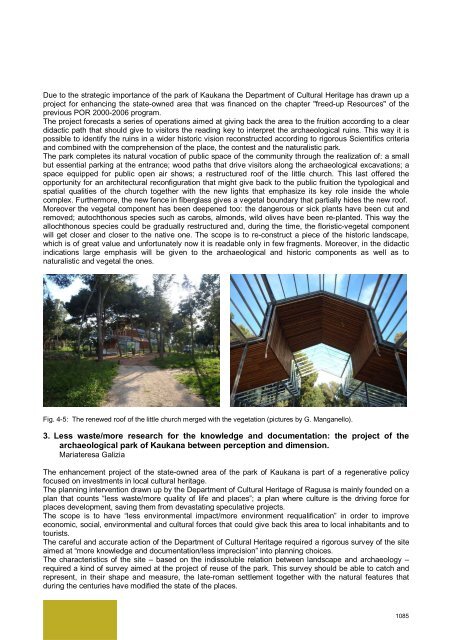Archaeology and nature: hyblean cultural landscape and territorial ...
Archaeology and nature: hyblean cultural landscape and territorial ...
Archaeology and nature: hyblean cultural landscape and territorial ...
Create successful ePaper yourself
Turn your PDF publications into a flip-book with our unique Google optimized e-Paper software.
Due to the strategic importance of the park of Kaukana the Department of Cultural Heritage has drawn up a<br />
project for enhancing the state-owned area that was financed on the chapter "freed-up Resources" of the<br />
previous POR 2000-2006 program.<br />
The project forecasts a series of operations aimed at giving back the area to the fruition according to a clear<br />
didactic path that should give to visitors the reading key to interpret the archaeological ruins. This way it is<br />
possible to identify the ruins in a wider historic vision reconstructed according to rigorous Scientifics criteria<br />
<strong>and</strong> combined with the comprehension of the place, the contest <strong>and</strong> the naturalistic park.<br />
The park completes its natural vocation of public space of the community through the realization of: a small<br />
but essential parking at the entrance; wood paths that drive visitors along the archaeological excavations; a<br />
space equipped for public open air shows; a restructured roof of the little church. This last offered the<br />
opportunity for an architectural reconfiguration that might give back to the public fruition the typological <strong>and</strong><br />
spatial qualities of the church together with the new lights that emphasize its key role inside the whole<br />
complex. Furthermore, the new fence in fiberglass gives a vegetal boundary that partially hides the new roof.<br />
Moreover the vegetal component has been deepened too: the dangerous or sick plants have been cut <strong>and</strong><br />
removed; autochthonous species such as carobs, almonds, wild olives have been re-planted. This way the<br />
allochthonous species could be gradually restructured <strong>and</strong>, during the time, the floristic-vegetal component<br />
will get closer <strong>and</strong> closer to the native one. The scope is to re-construct a piece of the historic l<strong>and</strong>scape,<br />
which is of great value <strong>and</strong> unfortunately now it is readable only in few fragments. Moreover, in the didactic<br />
indications large emphasis will be given to the archaeological <strong>and</strong> historic components as well as to<br />
naturalistic <strong>and</strong> vegetal the ones.<br />
Fig. 4-5: The renewed roof of the little church merged with the vegetation (pictures by G. Manganello).<br />
3. Less waste/more research for the knowledge <strong>and</strong> documentation: the project of the<br />
archaeological park of Kaukana between perception <strong>and</strong> dimension.<br />
Mariateresa Galizia<br />
The enhancement project of the state-owned area of the park of Kaukana is part of a regenerative policy<br />
focused on investments in local <strong>cultural</strong> heritage.<br />
The planning intervention drawn up by the Department of Cultural Heritage of Ragusa is mainly founded on a<br />
plan that counts “less waste/more quality of life <strong>and</strong> places”; a plan where culture is the driving force for<br />
places development, saving them from devastating speculative projects.<br />
The scope is to have “less environmental impact/more environment requalification” in order to improve<br />
economic, social, environmental <strong>and</strong> <strong>cultural</strong> forces that could give back this area to local inhabitants <strong>and</strong> to<br />
tourists.<br />
The careful <strong>and</strong> accurate action of the Department of Cultural Heritage required a rigorous survey of the site<br />
aimed at “more knowledge <strong>and</strong> documentation/less imprecision” into planning choices.<br />
The characteristics of the site – based on the indissoluble relation between l<strong>and</strong>scape <strong>and</strong> archaeology –<br />
required a kind of survey aimed at the project of reuse of the park. This survey should be able to catch <strong>and</strong><br />
represent, in their shape <strong>and</strong> measure, the late-roman settlement together with the natural features that<br />
during the centuries have modified the state of the places.<br />
1085
















